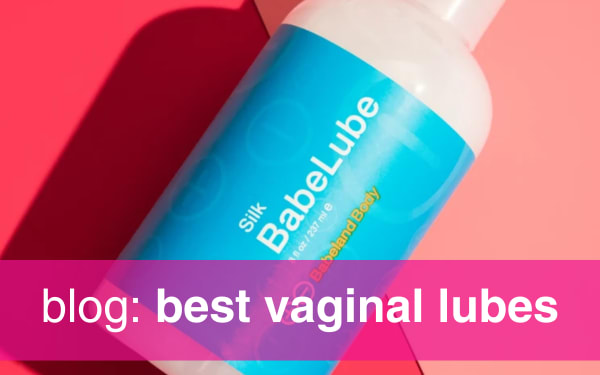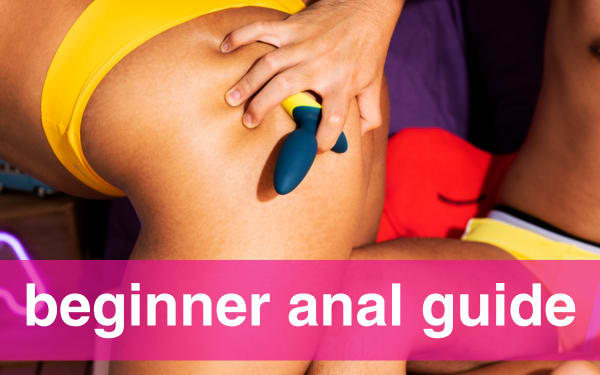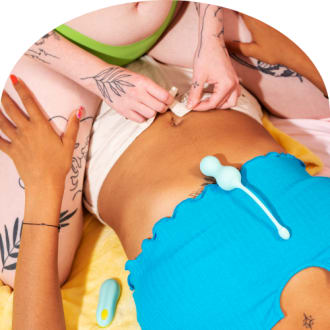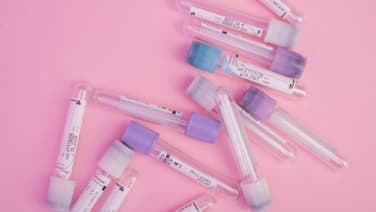9 Things Queer People Can Do To Support Their Sexual Health and Well-Being
Sexual health is important for people of all genders and sexualities. Yet, queer folks' sexual health is often overlooked by sex educators and healthcare professionals alike.
“Currently, sexual education curriculums in schools are centered around heteronormative ideals and values,” says psychotherapist Kim Hertz LCSW-R with NY Therapy Practice in New York City. Indeed, only 9 states have policies that mandate that sex education be inclusive of LGBTQI+ people, while 8 states explicitly require teachers to portray LGBTQ+ populations negatively in their lessons. Worse, only 39 percent of healthcare providers feel like the have the prerequisite knowledge needed to provide
To fill some of these gaping knowledge gaps, we put together this queer sexual health guide. Ahead, queer-informed sex therapists, mental healthcare providers, and doctors touch on the ABCs of safer sex—anal, barriers, and communication, that is.
First, What Is Sexual Health?
Contrary to common misconception, sexual health is farr more than your STI or pregnancy status.
“It is not merely the absence of disease, dysfunction or infirmity,” according to The World Health Organization. Rather, it is a broad term that takes your mental, emotional, physical, and social well-being into account.
Put simply, “your sexual health is your health,” says Rachel Wright, MA, LMFT, New York-based licensed psychotherapist and host of The Wright Conversations podcast. “It is a combination of your mental, relational, emotional, and physical health,” she says.
If you’ve ever gone to Pound Town when you’re feeling under the weather or received an agitating email from your boss before going bare, you know from experience just how much your capacity for pleasure is reduced by those niggling, lingering issues outside of your bedroom.
 Why Sexual Health Education Is Important For Queer People
Why Sexual Health Education Is Important For Queer People
When queer people get the sexual health education that pertains to them, they can climb between the rainbow sheets knowing exactly what is needed to make that sex as safe and as pleasurable as possible, says Wright. Meanwhile, not being equipped with this knowledge can translate to worsened physical, mental and emotional health, says Hertz.
The fact is that there are some risks to having sex. And if someone having sex isn’t informed about those potential consequences and how to avoid them, they are more likely to assume those risks. One 2024 study found that withholding comprehensive education from people doesn’t stop them from having sex, it just stops them from having safer sex.
The dearth of sexual health information can negatively impact overall emotional health and sense of self, too. “Not being included in sexual health curricula can lead queer people to experience feelings of alienation, exclusion and otherness, all of which can diminish self-esteem and contribute to negative thoughts around queerness and queer relationship configurations,” says Hertz.
Queer individuals may also feel their relationships are not valid or that their sex doesn’t count as “real sex” because it does not conform with what is being educated on, she says. “This can lead to inadequacy and shame about sexual identity and orientation.”
The 9 Sexual Health Practices For Queer People To Know About
Curious what kind of information a queer-inclusive sex education curriculum would include? Ahead, 9 sexual health practices specifically for queer folks.
1. Communicate, communicate, and communicate some more
“Communication is the key to positive sexual relationships,” says Hertz. And that stands whether the “relationship” is with a one-night stand, friends with benefits , new boo, or long-term partner, she says.
Openly talking about sexual likes and dislikes, fantasies and fetishes, wants and needs can help create a dynamic of trust, connection and understanding among partners and potential partners, she says.
Meanwhile, when that sexual intel is well-received, it can foster emotional intimacy, feelings of safety, and even boost sexual self-esteem and confidence, she says.
2. Talk about safer sex protocols before sex
The best time to exchange info about current STI status is before getting down and dirty when clothes are still on, says Hertz. “This allows everyone to explore any difficult feelings or situations that need to be addressed,” she says. It also ensures a person knows what risk profile they are consenting to.
When sharing your sexual health status, as well as planning out the safer sex practices that you want to use, be specific. On the STI status front, “you want to talk about when you were last tested, what you were tested for, what those results were, and what you’ve done since you were last tested,” says queer sex educator Cassandra Corrado, who is better known as @feministsexed on Instagram.
Meanwhile, because everyone has different definitions of safe sex, as well as different risk tolerance levels, Hertz says that it’s essential to get into the nitty-gritty of what sex acts are on the table, as well as what barriers (i.e. condoms, gloves, finger cots, dental dams) you’d like to use and when.
3. Stay up to date on your own STI status
Hate to be Captain Obvious, but you can’t share your STI status with a potential hook-up or lover, unless you know your current STI status. That’s why most experts recommend getting tested after every new sexual partner, as well as if there was a known potential exposure or you’re experiencing any symptoms.
Remember: “There is no shame in testing positive for an STI, as it's incredibly common,” says Corrado. And most can be cured or treated to reduce symptoms as well as risk of spread.
4. Consider using barriers during oral sex
You might not be able to get pregnant during oral sex, but that doesn’t mean it's totally risk-free. “It is possible to get an STI from performing oral sex on a penis, vulva, or anus,” says Corrado. Indeed, chlamydia, gonorrhea, syphilis, and herpes are just some of the infections that can be transmitted from the genitals to the mouth.
Here to reduce this risk are condoms and dental dams. These provide a physical barrier that prevents fluid transfer as well as skin-to-skin contact, explains Corrado. There are flavored variations available, she says, “but you could also use regular, unflavored products and add flavored lubricants.”
5. Talk to your provider about PrEP and PEP
“We are currenting in a PrEP, Doxy, and PEP era which help mitigate risk of HIV transmission as well as some other other STIs,” says Evan Goldstein, D.O., a doctor in New York City who specializes in anal care and founder of Bespoke Surgical and author of Butt Seriously.
In case you don’t know: Pre-Exposure Prophylaxis (PrEP) is a prescription medication that people who are currently HIV-negative can take daily to reduce the risk of transmission if they come into contact with the virus, explains Corrado.
Meanwhile, post-exposure prophylaxis (PEP) is a medication that can be taken within 72 hours of unprotected sex to to reduce the risk of HIV-transmission, she says. “You can also take Doxy (Doxycycline) within 72 hours of unprotected sex to reduce the risk of certain bacterial STIs.”
6. Consider other preventive tools, too
“You can also talk to your health care provider about certain preventative tools you may be able to use,” says Corrado. If you have herpes, for example, you may be eligible to take an antiviral medication that reduces your risk of outbreaks and lower your transmission risk, she says. Meanwhile, if you have HIV, you can take an antiretroviral treatment (ART) that suppresses the viral load.
Plus, “folks of all genders are able to get the HPV vaccine, which prevents the strains of HPV that are most likely to develop into certain cancers,” says Corrado.
7. Go slow during anal
Look, you might want to be able to go from zero to butt-banging, but that’s just not realistic, according to Dr. Goldstein. “Most people need practice and patience in order to take it anally.”
Why? Comfortably putting something in your pucker requires two things: Your anal sphincter muscle needs to be able to relax fully and the surrounding skin needs to be able to stretch, explains Dr. Goldstein. If either of these do not happen, the delicate anal tissues can become injured, he explains.
Thing is, neither of those things can happen overnight, nor in the course of one just. The safest way to work up to anal sex is through anal training, which is a gradual process that teaches our anus how to relax and stretch, Dr. Goldstein explains. It involves slowly increasing the size of the penetrative device—usually, a dilator or an anal training kit—over the course of weeks or months, he says.
8. Douche mindfully
Douching, which is the process of deep-cleaning your anus and rectum, is a common practice amongst those who take it in their backdoor.
Poop isn’t stored in the anal canal and therefore the risk of accidents during peach play is lower than many people fear. Still, douching can help some folks let go of lingering stress around mess, so that they can fully enjoy all the pleasure anal sex has to offer.
Unfortunately, “many people over-douche, which can mess with the anal microbiome can lead to many negative consequences like increased risk of infection and injuries” says Dr. Goldstein.
That’s why he recommends that people who do douche use a solution with the same pH as the anal cavity, which muck with that internal equilibrium. If you do use water, it’s best to use warm (not hot) water and limit the practice to twice per week.
9. Share toys responsibly
Given that your buzzy-buddies can bring you bliss in, like, ten seconds flat, it makes sense that you’d want to share your faves with your boos and besties. Not to mention, sex toys like dildos, harnesses, butt plugs, and prostate massagers, open up a world of penetrative possibilities.
Before you introduce your fave inanimate object to your partnered play, or loan out your vibrators left and right, however, it’s important to understand how to safely share sex toys.
Turns out that “in very specific contexts, it is possible that sharing a sex toy can result in STI transmission,” according to Corrado. “If you are positive for gonorrhea, for example, and you penetrate yourself with a dildo, then use that same dildo to penetrate your partner, there could be a transmission of bodily fluids,” she says.
The solution: If you are sharing a sex toy with someone who is STI-positive, or whose STI status you don’t know, one option is to slide a condom over the toy. Simple can the soiled condom and sheath the toy with a new rubber.
Another option before handing it off like a baton in a relay race is to hit up your sink. Vibrators made from silicone or any other non-porous material (i.e borosilicate glass, ABS plastic, stainless steel) can be cleaned with warm warm water and fragrance-free soap. Though, a sex toy cleaner or sex toy wipe works just as well.
Gabrielle Kassel (she/her) is a queer-inclusive, health-informed, pleasure-inclusive, sex-positive journalist and educator whose work reflects the intersections of LGBTQ+ issues, sexual health, wellness, and pleasure. Her work has appeared in publications such as Shape, Cosmopolitan, Well & Good, Health, SELF, Healthline, Women’s Health, Men's Health, and more.























